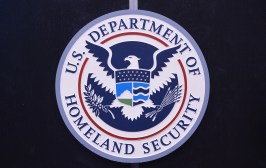The images coming out of Ferguson, Missouri, have put the Pentagon on the defensive as mainstream media outlets question the department’s program to transfer excess military equipment to state and local law enforcement agencies. But the so-called militarization of local police departments may have less to do with the Defense Department and far more to do with post-9/11 Department of Homeland Security counterterrorism grant programs.
Pentagon spokesman Navy Rear Adm. John Kirby said during a press conference Tuesday the Defense Department’s program to transfer excess military equipment to local law enforcement agencies is an effort approved by Congress in existence since 1991. When asked what the police department in Ferguson had received, Kirby provided a list that did not include many of the military-style items that have been captured on video and in images during rioting that was sparked by the shooting of an unarmed black teenager by a white police officer.
Since 2007, the Defense Logistics Agency has transferred “two humvees, one generator and one cargo trailer to the Ferguson Police Department,” Kirby said. “Now, in all of St. Louis County, over that same period of time, which includes Ferguson, six pistols, 12 rifles, 15 weapon sites, an EOD robot, three helicopters, seven humvees, as I said, two of which are being used by Ferguson, and two night-vision devices. That’s what they got.”
 The BearCat armored vehicle is sold to law enforcement agencies around the country and is often financed through grant money provided by DHS. (Photo: Lenco Armored Vehicles)
The BearCat armored vehicle is sold to law enforcement agencies around the country and is often financed through grant money provided by DHS. (Photo: Lenco Armored Vehicles)Photos from Ferguson show a police special operations unit manning sniper rifles atop a BearCat armored vehicle. The BearCat is manufactured by Lenco Armored Vehicles. With a price tag of more than $250,000, the armored vehicle is often acquired through grant applications. At press time, the Lenco website was down due to having reached its “bandwidth limit.”
But the body armor, ballistic helmets and shields and other specialized military-style clothing, such as battle dress uniforms, that are now commonplace across the country are part of the DHS Authorized Equipment List, from which states can purchase the items through multiple homeland security grant programs, including the Urban Area Security Initiative, the State Homeland Security Program (SHSP) and Operation Stonegarden. However, a review of the guidelines included with the DHS AEL shows that the department forbids the use of tactical law enforcement protective equipment purchased with funds from these grant programs for riot control.
“This item is for use only by specialized teams such as Tactical Entry or Special Weapons and Tactics (SWAT) Teams,” reads the AEL listing for ballistic helmets. “Not for riot suppression.”
DHS spokesman Peter Boogaard said the agency’s money under the State Homeland Security and Urban Areas Security Initiative grant programs is governed by specific guidelines. “Local governments and municipalities have the authority to determine their needs and purchase equipment as prioritized by the State Administrative Agency (SAA) and the urban area,” Boogaard said in an email to FedScoop. “The SAA is also the only entity eligible to apply for these funds. [The Federal Emergency Management Agency’s] annual grant guidance details specific guidelines and eligible expenses under each grant.”
The $401 million SHSP provides funds to every state, which can then be disbursed based on that state’s homeland security strategy for “planning, organization, equipment, training, and exercise needs to prevent, protect against, mitigate, respond to, and recover from acts of terrorism and other catastrophic events.”
The UASI program made $587 million available in fiscal year 2014 to the 100 most populous metropolitan areas in the country. The specific amounts awarded to each city is determined by the relative risk of terrorist activity in those areas. The money can be used to “prevent, protect against, mitigate, respond to, and recover from acts of terrorism.”
The state of Missouri received approximately $121 million in DHS grants from 2005 through 2007. As part of this effort, the state received $45.8 million in State Homeland Security Program grants and $51.3 million in Urban Areas Security Initiative grants.
But the increasing concerns about the militarization of local police departments is shedding light on one of the challenges facing DHS: the agency’s visibility into how states and localities are actually spending federal grant dollars, if the federal government is funding duplicative programs and if states are sufficiently justifying their expenditures.
Chris P. Currie, the acting director of Homeland Security and Justice at the Government Accountability Office, said FEMA, which manages the preparedness grant programs for DHS, has not always coordinated its processes for reviewing the large homeland security grant programs. Not only does FEMA run the risk of awarding duplicative grants, but the agency does not currently have detailed knowledge of how funds are actually spent, he said.
“By allowing the state administrative agencies to determine how the money is distributed [FEMA and DHS] give up some granularity in oversight,” Currie said in an interview with FedScoop. “They don’t have that level of detail on projects and purchases.”
DHS has distributed more than $20 billion in homeland security preparedness grants as of 2011.





